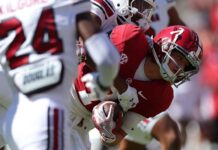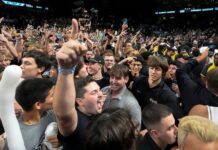[ad_1]
Destin, Fla. — As SEC spring meetings wrapped up Thursday, commissioner Greg Sankey acknowledged that while college athletics is in “uncharted waters,” he believes NCAA Division I schools can continue to work together, and his conference is prepared to “take a leadership role.” ” because they all navigate historical change.
Sankey said the NCAA basketball tournament in March that binds Division I together, but if it stays together, “there’s pressure that has to be acknowledged.”
“We let Division I grow,” he said. “We invited non-Division I members to the conference to address their membership issues, but we didn’t change the bracket size. I think common sense says you have to dig into it. There are competitive issues, there are calendar issues, but I think Just because March can be put together doesn’t mean it stays the same.
“We also need to recognize the differences that exist between groups pursuing that brass ring of tournament access opportunities.”
The SEC has formed several working groups to help address important issues that have arisen since the House v. NCAA settlement, including one to look at conference rules that may need to be removed or implemented. Another group will take a deep dive into the league’s federal law enforcement efforts, and another will look at settlement oversight and governance.
There is also a group of athletic directors looking at roster structure, which Sankey said needs to move quickly. Conference leaders agreed, however, that a big next step would be to see the filing of a long-form settlement, part of which would reveal how the plaintiffs plan to spread the historic damages, which began in 2016. Sources said they hope to know before July.
“This is the next step,” Texas president Jay Hartzell said. “We’ll see what their plans are. Not that we’ll shape it, but the public will start to learn what’s going to happen. It’ll be interesting to see what the response is based on how they plan to spend. We’ll all be watching.”
How that revenue is distributed among former athletes will affect the conversation about Title IX moving forward, as sources told ESPN this week that back pay could be lopsided toward men. It’s up to the plaintiffs, though, to determine how to allocate it to current athletic leaders. While back pay will provide some clarity, they still need to figure out how the money relates to federal law.
Oklahoma President Joe Harrows Jr. said questions about the settlement are “the whole universe right now.”
“When you look at it, it changes so much with the settlement,” he said. “It’s really this idea to make sure you’re in compliance with the settlement and we’ll continue to be the conference that leads the country.”
Sankey reiterated every day this week that critical answers to how revenue distribution for players on each campus will be implemented — and how Title IX factors in — will be part of a process that will continue over the next several months. The league’s in-person meetings, though, over the past month, have aided conference talks this week.
“I think we come out of here with an understanding that we’re going into a new chapter, we have to manage the transition, but the athletic director, the president and the chancellor level are fully prepared and committed across the board to that leadership role in that transition,” he said.
Sankey said the SEC will continue to work with the Big Ten in that role and said the advisory committee between the two was “a recognition of leadership responsibilities.”
He said they don’t currently have a meeting scheduled, but they are both interested in discussing their year-end meeting.
“We have to make independent decisions on many important issues,” he said. “We can’t solve every problem together, otherwise you reintroduce mistrust concerns. … We also have to draw people in, so it’s not like two votes change the world. Certainly two conferences agree on things and have an impact in the right way. “
The SEC on Thursday also announced new payout amounts for any team that qualifies for the 12-team playoffs, which begin this fall. Any SEC team advancing to the first round will earn $3 million, then an additional $3.5 million for a quarterfinal, $3.75 million for a semifinal and $4 million for an appearance in the national championship game. which is in addition to travel expenses. Sankey said those numbers are an SEC policy, and each conference can make its own decisions about its own payouts.
[ad_2]











